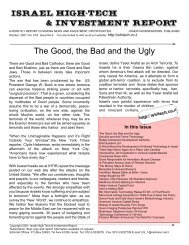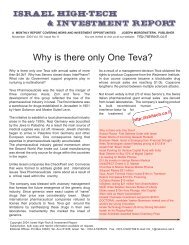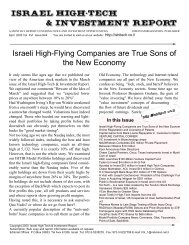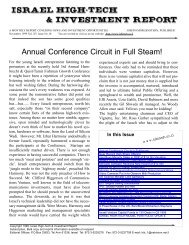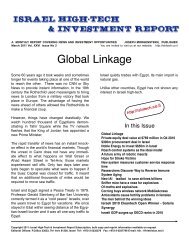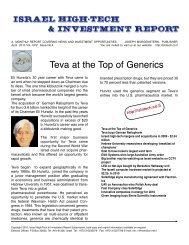A Quarter of a Century plus One - The Israel High Tech & Investment ...
A Quarter of a Century plus One - The Israel High Tech & Investment ...
A Quarter of a Century plus One - The Israel High Tech & Investment ...
You also want an ePaper? Increase the reach of your titles
YUMPU automatically turns print PDFs into web optimized ePapers that Google loves.
JANUARY 2013<br />
start-ups for potential investment.<br />
<strong>The</strong> hi-tech and entrepreneurship scene in Nazareth<br />
has been flourishing in recent months. In<br />
September, the city hosted a hackathon event<br />
in which 14 teams developed mobile apps for 30<br />
hours. <strong>The</strong> event was sponsored by companies<br />
such as Ts<strong>of</strong>en and Google <strong>Israel</strong>. This weekend,<br />
the city will host the “Start-Up Weekend”.<br />
<strong>The</strong> event will last for 54 hours and will bring<br />
together entrepreneurs who will work on various<br />
hi-tech projects. Start- Up Weekend Nazareth<br />
is organized by Juna Khalili, Sami Abboud and<br />
Bishara Rizk and is sponsored by JVP, CISCO<br />
<strong>Israel</strong>, Google, Mercy Corps, NGT, MEPI, NET-<br />
S<strong>Tech</strong> and the Business Hub in Nazareth.<br />
A history <strong>of</strong> Intel’s R&D in <strong>Israel</strong><br />
<strong>The</strong>re are dozens <strong>of</strong> multinationals with development<br />
centres in <strong>Israel</strong>, but no company has<br />
embraced the idea <strong>of</strong> <strong>Israel</strong>i-based R&D more<br />
than Intel.<br />
With four design centers and two fabrication<br />
plants, Intel is <strong>Israel</strong>’s largest private-sector<br />
employer, with about 8,000 direct workers.<br />
As the biggest tech company in <strong>Israel</strong>, it is<br />
responsible for much <strong>of</strong> the country’s hi-tech<br />
ecosystem, with one out <strong>of</strong> every 10 people in<br />
tech working either directly or peripherally for<br />
projects associated with Intel.<br />
intel haifaIntel’s R&D center in Haifa, <strong>Israel</strong><br />
(Image credit: Intel)<br />
Operating in <strong>Israel</strong> since 1974, some <strong>of</strong> <strong>Israel</strong>’s<br />
most important products were conceived,<br />
designed, and manufactured in <strong>Israel</strong>, according<br />
to Rony Friedman, Intel corporate vice<br />
president and general manager <strong>of</strong> the Intel<br />
Architecture Development Group (IADGz).<br />
“Intel <strong>Israel</strong>’s biggest contribution has been in<br />
the development <strong>of</strong> microprocessors, which<br />
are being used in a wide variety <strong>of</strong> products,<br />
for desktop, mobile, and workstation solutions,”<br />
says Friedman. “We also do work on connectivity<br />
products and security technologies here, as<br />
well as development <strong>of</strong> digital devices.”<br />
Among the technologies recently worked on<br />
by the <strong>Israel</strong>i team are Cedarview, Intel’s new<br />
processor for netbooks, and Cloverview, the<br />
processor that will be used in the new Windows<br />
8 tablets due later this year.<br />
Intel stars<br />
<strong>The</strong> first Intel product to put <strong>Israel</strong> “on the map”,<br />
says Friedman, was Banias, better known as<br />
the Pentium M microprocessor, the microprocessor<br />
introduced in 2003 that arguably kicked<br />
<strong>of</strong>f the notebook era.<br />
Intel shows <strong>of</strong>f 3D Tri-Gate transistors<br />
Another important product that, like Banias, was<br />
conceived, designed, directed and manufactured<br />
in <strong>Israel</strong>, was Merom, the Core-2 notebook<br />
processor heir <strong>of</strong> the Pentium M. Introduced in<br />
2006, Merom was the first Intel technology to<br />
produce a microprocessor for mobile, desktop,<br />
and server products, according to Friedman.<br />
“Merom especially helped boost Intel’s stature<br />
in the server market,” Friedman says.<br />
And <strong>of</strong> course, there are the current Intel stars:<br />
the Sandy Bridge and Ivy Bridge family <strong>of</strong> processors,<br />
all designed, manufactured, and managed<br />
by the <strong>Israel</strong> team.<br />
At a recent press conference, Intel revealed that<br />
Sandy Bridge was responsible for 40 percent <strong>of</strong><br />
the company’s sales worldwide in 2011.<br />
<strong>The</strong> more complicated products get, the more<br />
likely it is that teams from around the Intel world<br />
— notably the US and India, as well as <strong>Israel</strong> —<br />
will be working on products together, Friedman<br />
says.<br />
That appears to be the case with the upcoming<br />
Haswell processors: though they were largely<br />
designed in the US, the 22nm tri-gate 3D transistors<br />
inside them (and which are already<br />
8



